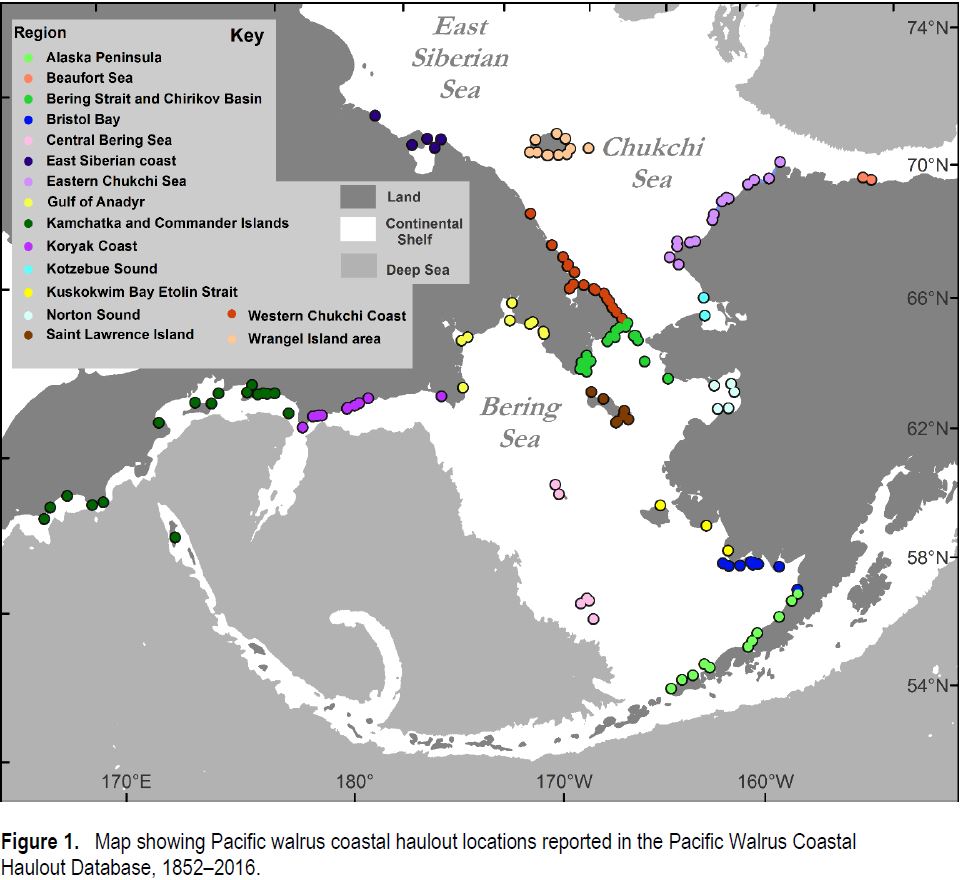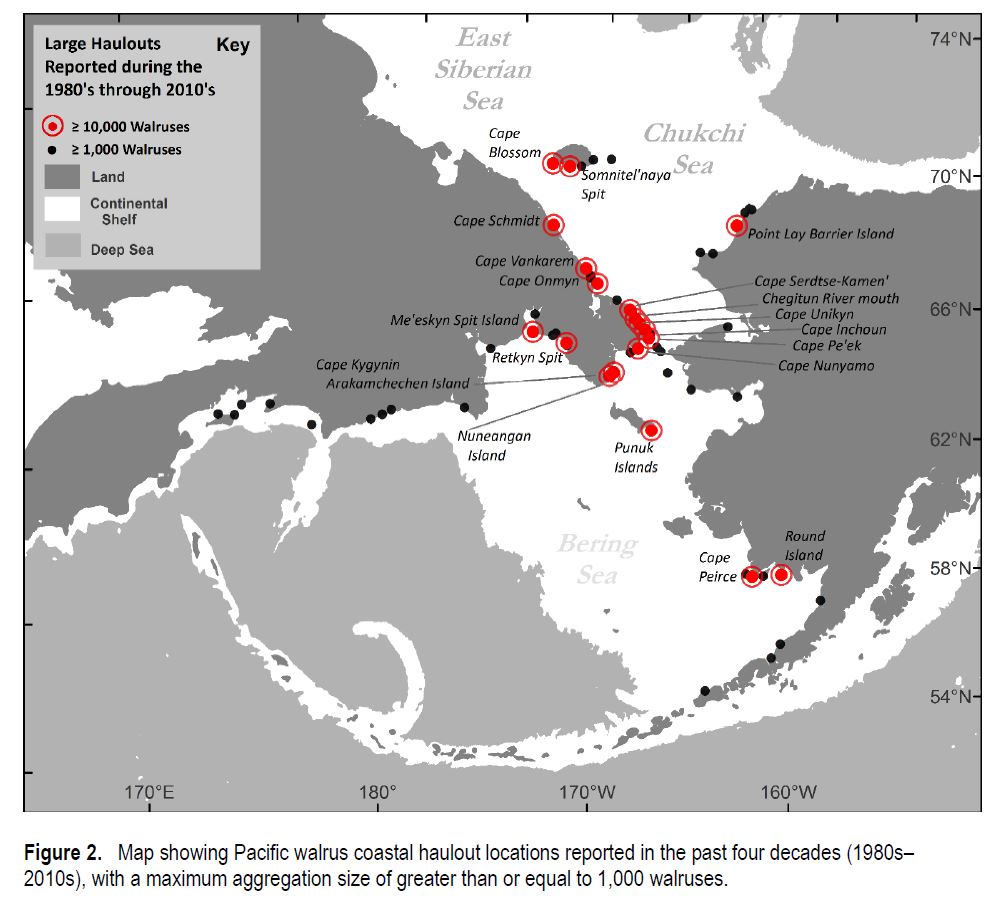By Dr. Susan Crockford
After years of hype, including documentary over-reach by David Attenborough and his collaborators at WWF and Netflix, there has been relatively abundant ice in the Chukchi Sea this summer, particulary along the Russian coast and around Wrangel Island, which in recent years have been important summer refuge areas for polar bears and Pacific walrus.

This year, there has been nothing like the complete retreat of ice into the Arctic Basin as happened in 2007, 2012, and 2020. The chart below shows the ice extent at 11 October 2021:

Wrangel Island was surrounded by ice in 2000 and 2001, which made access to walrus haulouts on the island impossible (Kochnev 2004). Most of the walrus haulouts along the Chukotka coast were also ice-covered in September in those years, as were all of the western locations in 2021 – as the ice charts below show. The extra ice will have drastically affected the distribution of walrus this year, which in turn will have meant no walrus carcasses for polar bears to feast on as they have done for many years now.
Only the south coast of Wrangel Island was ice-free by early September, which may have made a few haulouts accessible for a few weeks at most. Cape Blossom, a sandy spit at the western tip, has historically been a particular favourite for walrus in summer but this year looks to have been largely unavailable.

As the recent (18 October 2021) ice chart from the NOAA’s Alaska Sea Ice Program below shows, that ice along the Russian shore is now showing up as second-year ice that did not melt this year (brown is multi-year ice), with new ice (light and dark purple) forming beyond it.

In recent years, the pattern for mixed herds of females, calves, and older juvenile Pacific walrus has been to use western-most haulouts like Cape Schmidt in September (with its famous cliff that polar bears use as a hunting aid) but many move east to Vankarem in October. By late October/early November, virtually the entire Chukchi herd migrates even further east to the beaches at Cape Serdtse-Kamen where there is room for more than 100,000 of them to congregate (Chakilev and Kochnev 2019).
With winter approaching, the herd then moves east and south to join male walrus at land haulout sites in the northern Bering Sea where they wait to intercept the Chukchi Sea ice as it pushes south (Fay 1982; MacCracken et al. 2017).
The mobile ice that usually occupies the northern Bering Sea in winter (January-March) is critical to the survival of Pacific walrus because they need a mix of ice and open water for mating and feeding. Mating occurs in the water between the broken ice floes in December/January and calves resulting from mating events the previous year are born on the ice in spring (March/April). Cows need access to open water to feed on the ocean floor while nursing newborn calves. The Chukchi Sea in winter is too consolidated with thick ice for these activities.
Even in 2018 and 2019 (but not 2020), when winter ice in the Bering Sea was at a very low extent in February, there was apparently enough suitable ice for walrus needs, whether that ice was north or south of the Bering Strait: if there had not been, we would have heard about it by now. Note that geological evidence indicates that there was no ice south of the Bering Strait in winter for an extended period during the Eemian Interglacial (Polyak et al. 2010) and yet Pacific walrus survived (Fay 1982).
You can see on the labeled map below of the 18 October ice chart that both Cape Schmidt and Vankarem would have been inaccessible to walrus the entire summer which means no accumulated walrus carcasses for polar bears at Cape Schmidt this year!

This year, as for previous years when ice was present in the Chukchi Sea, walrus herds would have been able to feed from the ice in the Chukchi or used land haulouts in the Bering Strait or northern Bering Sea that have traditionally been used in late fall while waiting for winter ice to arrive. See haulout sites in the diagrams below from Fischbach and colleagues (2017): the first shows historically-known sites and the second shows sites where large haulouts have been documents since 1980.


References
Chakilev, M.V. and Kochnev, A.A. 2019. Monitoring results of the Pacific walrus (Odobenus rosmarus divergens) haulout site at Cape Serdtse-Kamen (Chukchi Sea) in 2016-2017. In, Marine Mammals of the Holarctic, Papers of The Tenth International Conference (29 October-2 November 2018), Volume 1, pg. 381-391. Marine Mammal Council, Moscow. [Russian and English]
Fay, F.H. 1982. Ecology and biology of the Pacific walrus, Odobenus rosmarus divergens, Illiger. US Department of the Interior, Fish and Wildlife Service, North American Fauna, No. 74.
Fischbach, A.S., Kochnev, A.A., Garlich-Miller, J.L. and Jay, C.V. 2016. Pacific walrus coastal haulout database, 1852-2016 – Background Report. USGS Open-File Report 2016-1108. DOI: 10.3133/ofr20161108 PDF HERE, download here.
Kochnev, A.A. 2004. Warming of eastern Arctic and present status of the Pacific walrus (Odobenus rosmarus divergens) population. In, Marine Mammals of the Holarctic, Papers of The Third International Conference (11-17 October 2004), Belkovich, V.M. (ed.), pg. 284-288. Marine Mammal Council, Moscow. [Russian and English]
MacCracken, J.G., Beatty, W.S., Garlich-Miller, J.L., Kissling, M.L. and Snyder, J.A. 2017. Final Species Status Assessment for the Pacific walrus (Odobenus rosmarus divergens). US Fish and Wildlife Service, Anchorage, Alaska.
Polyak, L., Alley, R.B., Andrews, J.T., Brigham-Grette, J., Cronin, T.M., Darby, D.A., Dyke, A.S., Fitzpatrick, J.J., Funder, S., Holland, M., Jennings, A.E., Miller, G.H., O’Regan, M., Savelle, J., Serreze, M., St. John, K., White, J.W.C. and Wolff, E. 2010. History of sea ice in the Arctic. Quaternary Science Reviews 29:1757-1778. http://bprc.osu.edu/geo/publications/polyak_etal_seaice_QSR_10.pdfd
Charctic hasn’t been updated since October 18:
https://nsidc.org/arcticseaicenews/charctic-interactive-sea-ice-graph/
Don’t want to show too much ice for COP 26 ?
Think you broke the code!
And this just in:
https://www.foodsafetynews.com/2021/04/traditionally-prepared-walrus-meat-connected-to-botulism-patients/
Walrus meat: not just for polar bears anymore!
There are also male walruses which specialize in killing polar bears. They’re distinguished by their thin, sharp tusks, stained orange with bear blood.
BLM (Bear Lives Matter)
VISHOP Is up to date: https://ads.nipr.ac.jp/vishop/#/extent
Thanks.
So above the average for 2011 to 2020 for yesterday’s date.
Still no update. But it’s Sunday.
Maybe tomorrow. Or after Glasgow.
Nope.
Finally. Shows Arctic sea ice higher yesterday than in previous five years on that date.
And well above the 2011-20 average. Only 2013-15 were higher.
Yes, Multani Russian friend shared a picture a couple weeks ago as to how much ice there is there compared to last year
So it will be a season of reruns for the doom squad viewing audience of uninformed.
Attenborough was seen climbing up hills on wrangle island to push some walruses down the cliff.
So there’ s a chance we get some new authentic walrus climate suicide documentary this year.
Na! They will just go somewhere else where they can claim that weather is catastrophic climate change. And if they can’t find it somewhere they’ll make something up, just like they did with the Walruses and Polar bears before.
Meanwhile in the real world, as Greta Scoldilocks continues to grumble and make faces, extinction rebellion causes disruption, suffering, and even death, and the COP 26 attendees ride to their failed forum in Tesla EVs charged with diesel generators; Real people in the real world are more worried about providing for their families, high gas prices, empty store shelves, and the destruction caused by vaccine mandates.
And I think that many more are finally waking up to the fact that Climate Change, COVID, and Supply Chain disruption are key weapons of the tyrants that will subjugate us all if they can.
Yep, we’ve got some catastrophic man-made global mudsliding coming to parts of California tomorrow. Gotta divert attention from the 4-day ending of of the catastrophic man-made global California droughting.
I doubt one part of your statement very much. Glasgow is in the middle of a train drivers strike and most of the COP delegates have lodgings in Edinburgh, not Glasgow. I doubt their EV’s will make the journey all the way around to get to Glasgow so I’m betting that if there are EV’s, they only do the last few miles for a triumphant entrance into the COP – it’ll be diesel motors the rest of the way.
A Fake Story. I didn’t read or hear anything about more ice this year in the Arctic in Washington Post, NYT or CNN. 🙂
There was a white-out. Nobody saw nuffink, honest Guv!
See polar portal graph sea ice update
http://polarportal.dk/fileadmin/polarportal/sea/SICE_curve_extent_LA_EN_20211022.png
Join the parade with World Walrus Foundation, a joint project of walruses and seals, and their [unPlanned] calves and pups playing in gay revelry.
What a great report.
Thank you
Do we deduce that poor sad Attenboro got it wrong way round? Global warming no ice allows haul outs, global cooling lots of ice doesn’t?
This clearly is not true! AlGore:The Goreacle said there is no ice in the Arctic and sea level has risen 20 meters in just the last 6 months. All the Polar Bears died 10 years ago, get with the program! 😉
Are you saying the Poly B’ars are gonna go hungry this winter? Does that mean I have to get out there with CARE packages for them again? Man, and I hate the cold weather, too. That means I’ll have to put my cat Punkin to work pulling the sledge with the CARE packages when she’d rather stay buried in her blankets.
And if you believe I do stuff like that, you owe me a big, fat bag of glazed donuts.
Life is hard in the wild, ain’t it?
Wait for the global warming causes increase in artic ice spin on this latest inconvenient truth.